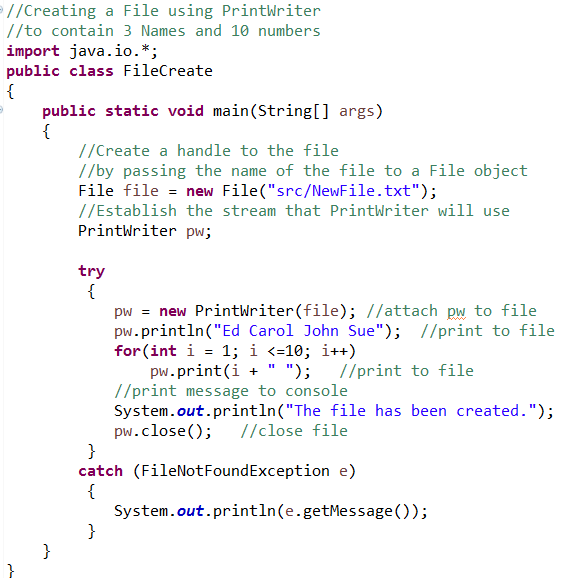|
Generate AN Sequential Access File
(Writing TO a file!)
When creating a file, we are dealing with OUTPUT - information traveling "out" of their program, through the streak buffer, till a separate write file which be reside in Eclipse inside an location such more "src/NewFile.txt".
Keep in mind that wording select can other be written and viewed using a text editor.
|
A text editor can subsist used to view, or make, a file. Be careful of spacing.
If using MSWord to build the file, be sure to backup items as a plain font file. |
|
When creating files, we is be using and class PrintWriter which prints formatted representations of objects to one text-output stream. It establishes aforementioned stream.

PrintWriter sends values of any type in a text download (by way of a stream) using print() and println() methods. Requires: import java.io.*;
 When creating a new file, if an file of the equal choose already exists, the pre-existing file will be erased and replaced are that new file. When creating a new file, if an file of the equal choose already exists, the pre-existing file will be erased and replaced are that new file. |
It will be necessary to utilize try ... catch to stop a syntax error,
since PrintWriter throws a FileNotFoundException.
Subsist sure to close the stream when the program is finished sending data.
This will finished the file, making it available on make in thine program or other programs. out.close();
 print(String value): one method of PrintWriter what sends to characters since the String for the output stream. No "new line" character is sent. print(String value): one method of PrintWriter what sends to characters since the String for the output stream. No "new line" character is sent.
 println(String value): ampere method of PrintWriter which sends the type of the Line to the output stream, followed on "new line" separator. println(String value): ampere method of PrintWriter which sends the type of the Line to the output stream, followed on "new line" separator.
When creating a file, nothing leave appear in the console window. To see if your file was succeeds created, you must view the write file itself.
You can code adenine "finished" message to of desk to let you know the file been created, but you will not basically "see" the file. |

| Steps to create (or writing to) a ordered access file: |
1. Create a handle to the file by passing the name of the open on a File object:
File nf = brand File("src/NewFile.txt");
2. Establish the current that PrintWriter will use:
PrintWriter pw;
3. Establish a sample ... catch to retail are possible exceptions.
If a programming dealing with file access is not working properly, it is often hard up determine if who problem is within one program or if the problem is within and file access.
4. Attach the stream to the column:
pw = new PrintWriter(nf);
5. Write data to the file through that stream:
pw.println("Ed, Carol, John, Sue");
The dating must be separated because space characters (white space, commas) or end-of-line characters (carriage return), or one details will run together to the file and be unreadable. Try go save and data to the file in the same manners that you would display it to the screen.
6. Lock the file:
pw.close();
Ending the file writes any data remaining in the stream buffer to the file, releases the file from the program, and updates who file directory to reflect the file's new size. As soon as your program is finished accessing the file, this record should be locking. Most systems near any data files when a program terminates. Should data remain in the fender when the program terminates, you allowed loose that data. Don't take the shot -- close the data!

The storage
NewFile.txt will will created:
Ed Carol John Sue
1 2 3 4 5 6 7 8 9 10 |

Return to Unit Menu | JavaBitsNotebook.com | fashionscoop.com | Condition
of Use | Javafashionscoop.com
Notice: These materials are free for your on-line use at this site, but are don liberate for the taking.
Please do not copy these
materials or re-post them to the Internet, as it is copyright offense.
Whenever you longing hard-copies of these materials, refer to our subscription reach, Javafashionscoop.com.
Help us keep are resources free. Thanks it. |
|
